Abstract
The present study was conducted in order to investigate the parameters influencing the extraction of condensed tannins from branches of Prunus spinosa L. as a source of biomass, using a two-level factorial design. The extraction of condensed tannins was performed using microwave assisted-extraction (MAE)—a green technique to produce concentrated and pure extracts. Experimental tests were run to establish the effects of independent variables on the extraction of condensed tannins (expressed as catechin and epicatechin), which were quantified using high-performance thin-layer chromatography–densitometry. Four process variables were evaluated: ethanolic solvent concentration (% v/v) (30, 70), liquid-to-solid ratio (mL/g) (6:1, 10:1), extraction time (min) (2, 5) and microwave power (W) (400, 600). The significant influencing parameters were liquid-to-solid ratio and solvent concentration. The maximum content of condensed tannins (3.4 mg g−1 catechin and 3.45 mg g−1 epicatechin) was obtained using 70% v/v ethanol, 10:1 liquid-to-solid ratio, 5 min of extraction time and 600 W microwave power. MAE is beneficial for increasing the amounts of the targeted compounds.
1. Introduction
A challenging task of the 21st century is pinpointed by the finding of new bioresources and their valorization by means of new, integrated and sustainable technologies. Extraction is a critical operation for separating the targeted natural products from raw materials. Several methods including pressing and sublimation, distillation, and solvent extraction [1] could be used. However, the latter is the most applied. Conventional methods of solvent extraction consist of decoction, maceration, digestion, percolation, infusion, superficial extraction, and Soxhlet extraction, whereas supercritical fluid extraction and, microwave-assisted and ultrasound-assisted extraction are green process intensification methods.
Microwave-assisted extraction (MAE) is inscribed among the advanced extraction procedures particularly fit for the separation of valuable compounds from the plant matrix. The technique relies on the mechanism of dipolar rotation and ionic conduction [2]. It uses microwave (electromagnetic) radiation, which is absorbed by the solid matrix, further converting it into heat and thus facilitating the diffusion of the solvent into the plant matrix. In the case of polar solvents, dipole rotation and the migration of ions occur, thus increasing the solvent penetration, and supporting the extraction process [3,4]. Faster extraction, higher yields, lower solvent consumption and moderate extraction temperature are the main benefits of MAE. Nevertheless, MAE presents several drawbacks, such as a high capital cost and maintenance of the equipment for effective operation, specificity for polar solvents, and poor efficacy for non-polar or volatile solvents. Large samples or aggregated small particles cannot be heated uniformly. Also, a cooling time is necessary after MAE [5,6,7].
Yingngam et al. showed that the MAE process accelerates the mass transfer rate and improves the extraction yield of triterpenes from leaves of C. asiatica, while consuming less solvent [8]. MAE is also powerful technique applied to extract phytochemical components from Quercus cerris bark [9]. The extraction of polyphenols from Eucalyptus globulus bark, using water as solvent and the MAE method, showed superior performance. Tomasi et al. reported the optimized parameters of this process: a liquid-to-solid ratio of 48.5 mL/g, an extraction time of 15 s, and 141 °C [10]. In the case of Quercus bark, MAE led to the increase of (−)-epicatechin, (+)-catechin, (−)-epigallocatechin, p-coumaric acid, syringic and sinapic acid, and naringenin content, compared to the control extraction sample at similar diffusion time and temperature [11]. Microwave-assisted extraction has been proved to be an efficient process for the extraction of polyphenols (33.6 ± 0.4 mg GAE/g DW) from carob bark under optimal extraction conditions (35 mL/g ratio, 35% ethanol, 29.5 min, and 80 °C) [12]. D. indica bark was used to separate betulinic acid using MAE, and process parameters were optimized (0.91% w/w, 200 W, 90 °C, 15 min) to raise the yield of the targeted molecule [13]. The optimal extraction parameters for obtaining ursolic acid from elder bark using MAE were 0.01 L g−1 ethanol, 60 min and 55 °C [14].
The extraction efficiency is influenced by extraction solvent, particle size, solvent-to-solid ratio, temperature, and duration [15,16,17]. Fractionation and purification of phytochemicals are achieved by applying various chromatographic techniques: high-performance (thin-layer) chromatography and gas chromatography. The obtained compounds are identified using various spectroscopy techniques such as infrared and ultraviolet, mass, and nuclear magnetic resonance spectroscopy [18].
It is well known that lignocellulosic biomass contains higher concentrations of tannins used as bioactive compounds in phytopharmaceutical, as well as in industrial, applications. The researchers’ attention was held by feedstocks such wood and bark from forestry species and very little by branches of shrub species like Prunus. Regarding the latter, the interest was focused on fruits and less on its woody by-products (branches), even if from these shrubs plantation maintenance activities and large quantities of branches are generated. Sadly, these are considered as waste instead of valuable feedstock for green biorefinery processing. In fact, the branches of genus Prunus may be a great source of tannins with important biological properties. The bark of P. cerasus and P. avium contain flavone C-glycosides (vicenin-2, isovitexin and chrysin-8-C-glucoside) [19]. P. domestica bark has in its composition flavan-3-ols (catechin and epicatechin), a phenolic glucoside (annphenone and six dimeric A-type proanthocyanidins with antimicrobial activity [20]. However, P. cerasoides extracts with antimicrobial and antibiofilm potential against some strains of pathogenic bacteria have also been reported [21]. Taking into account the widely studied biological activities of flavonoids, the barks of these common fruit trees seem to be also of interest for pharmaceutical, agricultural and industrial applications [22].
Belonging to the family of Rosaceae and the subfamily of Prunoideae, Prunus spinosa (blackthorn) is native to Europe and the Middle East [23,24]. It is a dense and spiny shrub growing to 1–2 m on the fringe of forests, clearings and pastures. Blackthorn is an abundant source of bioactive polyphenols, such as phenolic acids (chlorogenic acid, neochlorogenic acid, caffeic acid and protocatechuic acid), flavonoids, anthocyanins, as well as condensed tannins [25,26,27,28] with proved antioxidant effects [29,30,31].
To the best of our knowledge, there are no studies focused on the optimization of the microwave-assisted extraction of condensed tannins from P. spinosa branches, nor the use of a “green solvent” such as ethanol. Available literature data indicate that P. spinosa branches have been neglected and/or underexplored. This work was designed to complement current knowledge on P. spinosa by extracting condensed tannins from its branches. The main tannins quantified in this study are catechin and epicatechin, with the chemical structures presented in Figure A1 (Appendix A).
Since the one-factor-at-a-time approach is time-consuming, expensive, and does not consider interactive parameters [32,33], a two-level factorial design was developed to optimize the MAE extraction parameters (liquid-to-solid ratio, solvent concentration, extraction time and microwave power), in order to maximize the yields of catechin and epicatechin.
2. Materials and Methods
2.1. Sample
The biomass (branches of P. spinosa) was collected in the autumn, towards the end of the vegetation period, from Siret Valley, Bacau County, Romania, an unpolluted submontane, hilly area. The branches were analyzed according to Ph. Eur.6.0, chapter 2.8.2 as follows: parts of the same plant—fragments of branches with blackened internal surface—2.1%, parts of other plants, 0%, and other foreign elements (such as molds and animal contamination), 0%. The collected biomass was dried under normal conditions for about 20 days until it reached constant weight. A max. 13% weight loss from drying was obtained, measured with an infrared Kern MLS Thermobalance. The collected biomass was powdered, using a Microtom MB550 laboratory mill, to particles of 0.1 mm medium size. The sample was stored in a desiccator and further used for extraction and analysis.
The proximate analysis was performed in order to characterize the biomass: humidity (%), total ash (%) and insoluble ash in HCl 100 g/L. The moisture was determined using a Kern MLS 150-2A Thermobalance with a mass measurement range of 0–183 g ± 0.1 mg. The ash (total ash and insoluble ash in HCl) was assessed according to Ph. Eur, 7th ed., (chapters 2.4.16 and 2.8.1) using an L1003/720 calcination oven.
2.2. Chemicals and Reagents
Reagents used are as follows: ethanol (99.98%, Chimreactiv, Bucharest, Romania), ethyl acetate (Chromasolv for HPLC, 99.7%; Sigma-Aldrich, St. Louis, MO, USA), toluene (Chromasolv, for HPLC, 99.9%, Sigma Aldrich), formic acid (98–100% for analysis, Merck KGaA, Darmstadt, Germany), distilled water, prepared in lab using GFL 2001/4 equipment. The standards were purchased and used without any further purification: (+)-Catechin (CAS No. 154-23-4, Product No. 0976 S, ≥99% purity, Extrasynthese, Genay, France) and (−)-Epicatechin (CAS No. 490-46-6, Product No. 68097, ≥97% purity, Sigma-Aldrich, Saint Louis, MO, USA), as well as pre-coated silica gel 60 F254 HPTLC plates (20 cm × 10 cm) (Merck, Germany).
2.3. Raw Material Characterization Using ATR-FT-IT Spectroscopy
The FT-IR spectrum was recorded using an Agilent CARY 630 FT-IR spectrometer equipped with a single reflection diamond crystal in attenuated total reflectance-Fourier-transform infrared (ATR-FT-IR) mode, in 400–4000 cm−1 wavelength range, 64 scans at 4 cm−1 resolution, in duplicate. The sample was pressed against the diamond crystal using the attached pressure clamp.
2.4. Experimental Design and Statistical Analysis
The study of modeling and optimization of microwave-assisted extraction of condensed tannins from branches of P. spinosa L. was built on several steps: (1) first, the correlation between the independent variables and the responses were evaluated; (2) the models describing the factor influences on the considered responses were developed; (3) analysis of variance (ANOVA) was performed for each model in order to confirm its statistical validity; (4) the statistical significance of each factor and their interactions were also quantified by means of a Pareto plot; (5) the values predicted by the suggested models were experimentally validated; (6) several optimization criteria were imposed; and (7) response surfaces and corresponding contour lines were drowned to identify the optimized region of responses [34].
The independent variables affecting the extraction of condensed tannins were analyzed using a 2-level factorial design generated by means of Design Expert software (State-Ease Inc., Minneapolis, MN, USA, Version 7.1.5). Factors having the most significant effect on the concentration of condensed tannin extraction were identified. The developed experimental design is based on 16 runs. Parameters were analyzed for duplicates at high and low levels. The considered independent variables were ethanolic solvent concentration, % v/v, liquid-to-solid ratio, mL/g, microwave power, W, and extraction time, min.
Table 1 summarizes the ranges and levels of the studied variables. The factor effects with a confidence level of 95% (p < 0.05) were kept in the suggested models. The statistical significance of the linear effect of all four variables was assessed by ANOVA. The determination and adjusted R2 coefficients allowed for the evaluation of the suitability of the models. The significance of suggested model equations was established based on Fischer test [35]. Additionally, the adequacy of the models was pinpointed by normal probability plots.

Table 1.
The range and coded levels of independent variables.
2.5. MAE Experiments
Tests were carried out using laboratory Ethos X equipment (Milestone, Milan, Italy). The biomass (10 g) was weighed and added into a round-bottom flask. For each test, a round-bottom flask was filled with feedstock. As extraction solvents, 30 and 70% v/v ethanol were used. Each round-bottom flask was placed into a microwave extraction system Ethos X. The effects of four different parameters such as solvent concentration, liquid-to-solid ratio, microwave power, and extraction time were studied, and the extraction control was carried out by determining the catechin and epicatechin content. The extracts from all 16 flasks were collected and the volume was measured. The resulted extracts were analyzed and quantified in relation to condensed tannins (catechin and epicatechin) using HPTLC-densitometry [36,37].
2.6. Quantification of Condensed Tannins in MAE Extracts
The control of the process was performed by the determination of the condensed tannins catechin and epicatechin through HPTLC-densitometry in the MAE extracts. A total of 7 µL volume of each collected MAE extract and the reference compounds (+)-catechin and (−)-epicatechin (200 µg/mL per each) was placed on the HPTLC plate. Samples were applied as bands of 8 mm length, via a Linomat IV automatic sample applicator provided with a Hamilton syringe (100 µL), having a 5 s/µL dosage speed. The probes were prepared in a solvent system toluene: ethyl acetate: formic acid 12:12:2 (v/v/v) at a distance of 8 cm, at room temperature (21 ± 2 °C) and 45% relative humidity in an Automatic Developing Chamber saturated with mobile phase vapors for 20 min. The samples were dried for 10 min to evaporate the solvents and then introduced into the scanner stage (CAMAG Scanner 3), where scanning was carried out in white light using slit dimension 6 × 0.3 mm, scanning speed 20 mm/s, and data resolution 100 µm/step. The scan mode was single wavelength. The spectrum scan settings were slit dimension 6.00 × 0.30 mm, spectrum scan speed 100 nm/s, and data resolution 1 nm/step. The densitograms were registered and the catechin and epicatechin content (mg/g biomass) in the MAE extracts was calculated based on the recorded peak area.
3. Results
3.1. Raw Material Characterization
The proximate analysis (Table 2), consisting of the determination of moisture (%), total ash, and the insoluble-in-HCl-100 g/L [38], soluble substances (extractable) (%) in different extraction solvents: ethanol 30, 50, 70% v/v, distilled water, methanol, solution density (g/mL), pH, and residue (%), was carried out according to the methods described in Section 2.1 and in the laboratory analytical procedures for standard biomass analysis (NREL) [39].

Table 2.
Proximate characterization of P. spinosa raw biomass.
The extractables (soluble substances) determined in different solvents provides valuable data in establishing the conditions for extracting the bioactive compounds. The solvents used to analyze the soluble substances resulted in extractable values between 5.95 and 9.00%, the lowest value corresponding to water solvent and the highest value obtained when ethanol 50% v/v is used. It was also noted that there was a slightly acidic pH, between 5.38 (water) and 6.76 (methanol), and an inversely proportional increase in the solution density with the alcohol degree of the hydroalcoholic solvents used.
Following the global physicochemical analysis, preliminary valuable data were obtained regarding the extraction conditions and solvents that could facilitate the extraction of the targeted bioactive compounds. It was found that the solvents that provide the highest percentage of extractives and residue are the 50% v/v and 70% v/v hydroalcoholic ethanol solvents.
The qualitative analysis carried out using FT-IR spectrophotometry aimed to pinpoint the functional groups in the chemical structure of the bioactive compounds. Figure 1 shows the spectrum of P. spinosa biomass. Analysis using Fourier-transform infrared spectroscopy revealed intense absorption bands corresponding to the stretching vibrations of the free hydroxyl (OH) group of the phenolic type at 3279 cm−1, aromatic C-H and C=C of the aromatic nucleus at 2903 and 1726 cm−1, respectively, C-O of the structure of alcohols, ethers or esters at 1235 cm−1, and C-O-C from the glycosidic structures at 1022 cm−1.

Figure 1.
FT-IR spectrum of biomass.
The qualitative and quantitative assessments of catechuic tannins in P. spinosa biomass were performed using HPTLC densitometry analysis and calculated based on the peak height by means of winCATS software (version 1.4.3). The procedure highlighted a complex and rich tannic profile that include catechin 3.4 mg/g, catechin gallate 1.09 mg/g, gallocatechol 1.85 mg/g, epicatechin 3.45 mg/g, epigallocatechin 2.26 mg/g, epigallocatechin gallate 1.65 mg/g, and neochlorogenic acid 1.43 mg/g.
3.2. Quantitative Determination of Catechuic Tannins in P. spinosa Extracts Using HPTLC-Densitometry
The results of the densitometric quantification of catechuic tannins were processed graphically and presented in Figure A2 and Figure A3 (Appendix B). Catechin and epicatechin were simultaneously quantified from P. spinosa extracts. The amount of these compounds was found to range between 1.79 mg/g and 3.18 mg/g in the case of catechin, and between 1.79 mg/g and 3.57 mg/g for epicatechin.
3.3. Screening of Significant Variables Using Two-Level Factorial Design
The experimental design factors were chosen based on preliminary monofactorial experiments carried out in order to estimate the variation range of the main parameters (the solvent concentration, the solid-to-liquid ratio, the extraction time and irradiation power), as well as their synergic influence on the targeted compound concentration.
The monofactorial experiments outlined several aspects regarding MAE parameters: (i) a solvent concentration lower than 50% v/v and higher than 70% v/v results in lower yields for catechin and epicatechin, because too much, either distilled water or ethanol 96% v/v in the extraction solvent, leads to lower yields; (ii) a liquid-to-solid ratio lower than 6:1 does not provide enough solvent for the moistening and extraction of biocompounds from the plant matrix; the extraction efficiency increased obviously with the increase in the solvent volume before the liquid-to-solid ratio reached 1:12, and the efficiency significantly decreased with the further increase in the solvent amount; (iii) the extraction time plays another predominant role in the microwave-assisted extraction. However, the extraction efficiency increased with time up to 5 min; afterwards, the effect of this parameter was negligible; and (iv) a higher microwave power caused a more obvious rupture of the cell wall of the plant matrix; the high absorption of microwave energy caused a rapid temperature increase in the extraction vessel. High values of microwave power determine a decrease in extraction yield; in the range 100–300 W, the extraction temperature is relatively low (unfavorable for the extraction of tannins from the plant matrix), while in the range 400–600 W, the microwave power ensures a temperature of the extracts higher than 65 °C, thus facilitating the obtaining of good yields for catechuic tannins. When the microwave power is above 600 W, the temperature of the extract is around 77~80 °C, thus inducing a degradation of the tannins.
The extraction process of the condensed tannins catechin and epicatechin from P. spinosa branches was carried out in 16 experiments of the experimental design. The optimized condition was selected for a maximum concentration of catechin and epicatechin. Table 3 shows the simplified experimental design and the obtained results for each run, Response 1 (catechin, mg/g biomass) and Response 2 (epicatechin, mg/g biomass), respectively.

Table 3.
Experimental matrix and experimental values of responses.
Based on Table 3, the highest concentration of condensed tannins was obtained in Run 16, with 70% v/v ethanolic solvent, 10:1 liquid-to-solid ratio, 5 min of extraction and 400 W microwave power, which yielded 3.40 and 3.45 mg/g biomass w/w of catechin and epicatechin, respectively. Thus, a higher level of extraction parameters has a favorable effect on the content of catechin and epicatechin. Yet, Run 12 indicates that a short extraction time, 2 min of irradiation, in similar conditions as mentioned before, can also ensure a considerable content for the condensed tannins of interest, 3.18 mg catechin/g biomass and 3.16 mg epicatechin/g biomass. Therefore, a short irradiation time, 2 min, did not significantly affect the content of the extract. However, low values of ethanolic solvent, liquid-to-solid ratio and extraction time resulted in the lowest values for catechin and epicatechin content, despite the high irradiation power. For instance, Run 9 yielded 1.79 mg catechin/g biomass and 1.55 mg epicatechin/g biomass. These results indicate that ethanolic liquid-to-solid ratio and solvent concentration are the factors of highest significance for the extraction performance, whereas extraction time and irradiation power are less significant factors compared to the other two.
A useful tool for emphasizing the relative significance of the independent variables, a Pareto chart, was employed to evaluate the impact of independent factors on R1 (catechin content). Variables with calculated t-values higher than the t-limit line have significant effects, and, if higher than the Bonferroni limit, they are statistically significant. Any variable or interaction lower than the t-value limit of 2.57058 is considered insignificant. According to the Pareto charts (Figure 2), the liquid-to-solid ratio is the major contributing variable that has the greatest influence on catechin content, with a 59.24% contribution, which is followed by the ethanolic solvent concentration (28.37% contribution), and extraction time and microwave power, which had a modest effect (3.28% contribution for each) on catechin content. All the variables had a positive effect on the extraction of catechin from P. spinosa branches.
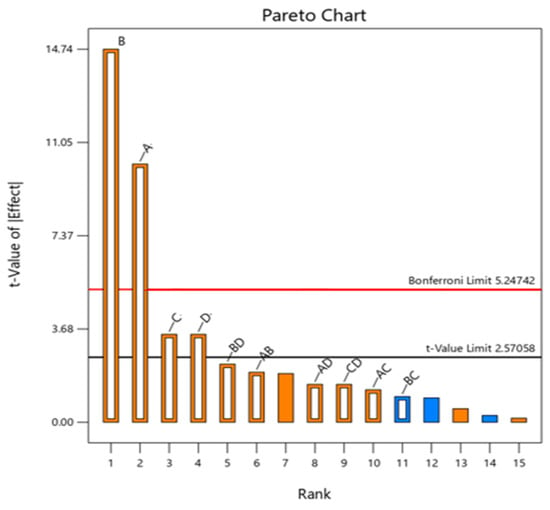
Figure 2.
Pareto chart—the effects of independent variables (described in Table 1) and their interactions.
The significance of the main factors and interactions on the content of catechin and epicatechin were calculated and analyzed using ANOVA based on a 95% confidence interval, as shown in Table 4. Model terms with p-values lower than 0.05 are significant. In relation to the model, it shows they are suitable for describing the experimental data. Therefore, the main effects (A, B, C, D) and the interaction BD are significant.

Table 4.
ANOVA test for catechin content model.
Statistical analysis of Response 1, catechin content, highlights the fact that the value of 43.69 determined for the model F implies that the suggested model is significant. The determination (R2) and the adjusted (adjusted R2) coefficients were 0.9562 and 0.9343, respectively, indicating also that the model fits the data. The Residuals versus Predicted Graph checks for consistent variation across the prediction range, and in our analysis shows a random scatter of predicted residuals centered on zero. Further on, residual analysis was carried out to confirm that the ANOVA assumptions were met. The model adequacy was assessed based on normal probability plots of residuals, residual values versus fitted, and experimental values (Figure 3a–c). Diagnostic plots for studentized residuals showed that for the Normal plot the values are grouped along a straight line, while the Residuals vs. Predicted and Residuals vs. Run show a random scatter, and no trends are formed.
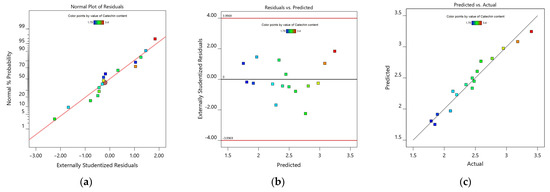
Figure 3.
(a) Normal probability plot for residuals, R1 (catechin content); (b) Plot of residual vs. predicted values for R1 (catechin content); (c) Plot of residuals vs. experimental values for R1 (catechin content). Square symbols are colored by R1 value, blue—the lowest, green—average, red—the highest.
Optimization of experimental conditions for MAE for R1: the following equation was determined:
where R1 is the content of catechin (mg/g biomass), A—ethanolic solvent concentration, B—liquid-to-solid ratio, C—extraction time, D—microwave power, and BD—interaction between liquid-to-solid ratio and microwave power.
R1 = 2.44 + 0.2388A + 0.345B + 0.0813C + 0.0813D + 0.0537BD
It was found that all main factors (A—ethanolic solvent concentration, B—liquid-to-solid ratio, C—extraction time, and D—microwave power) have a statistically significant effect on P. spinosa extracts. The graphs of the model (Figure 4) show the effects of the significant factors on the catechin content from P. spinosa extracts. The increase in the value of factors A (solvent concentration) and B (liquid-to-solid ratio) is reflected in an increase in the value of the response. It can be seen that a high value for the contribution of factors A and B determine a greater slope, which means a greater influence on the recovery. Factors C (extraction time) and D (microwave power) also show an increasing influence on the response, yet of in lower degree. An increase in ethanolic solvent concentration and liquid-to-solid ratio determines higher recoveries of catechin content for the extract. The line plot for solvent concentration showed a significant slope gradient. This may be due to the solubility of P. spinosa branches in aqueous ethanol solution. Hence, the percentage of ethanol influences significantly the catechin content. Chew et al. [40] found that water favors the increase in the contact surface area between the solvent and the biomass, resulting in an enhanced extraction efficiency. Consequently, bioactive compounds can be optimally extracted using an aqueous alcohol [41,42]. The solvent gradient in the plant matrix is the main driver of the extraction process until an equilibrium is established between the solvent and the plant matrix [43]. The extraction starts once the electromagnetic waves are generated by the magnetron. The interaction of the microwaves with water molecules in the plant matrix and polar solvent results in the increase in temperature. Tissues and cell walls interact with the electromagnetic waves. Electromagnetic energy causes the evaporation of water from the plant’s matrix, causing a considerable pressure and the deformation of the cellular and subcellular walls. This deformation brings structural changes in the plant matrix, thus generating an increased mass transfer of dissolved substances as a result of cell destruction, and thus facilitating the extraction of tannins from the plant cell matrix [5,6,7].
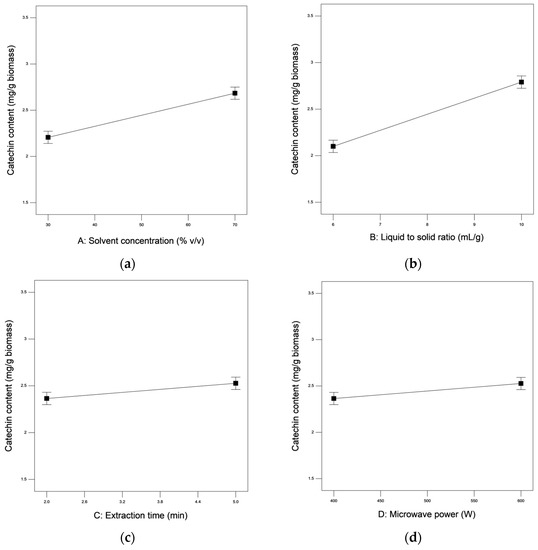
Figure 4.
Plots of marginal means of catechin content as influenced by (a) solvent concentration, (b) liquid-to-solid ratio, (c) extraction time and (d) microwave power.
In the case of MAE, solvent concentration and microwave power are the main factors influencing the quality and quantity of the yields [42,44]. The catechin content increases with the ethanol concentration. However, the Pareto plot pinpoints the fact that the liquid-to-solid ratio was the factor contributing most to attaining a higher concentration of catechin.
Figure 5 shows a significant interaction effect on the extraction of catechin from P. spinosa branches. Interaction BD (liquid-to-solid ratio with microwave power) has a significant effect, with a p-value < 0.0001. The interaction effect shows a non-crossed and non-parallel line, known as an ordinal interaction. The interaction BD is significant, due to both factors contributing more to the catechin content in comparison with the other factors.
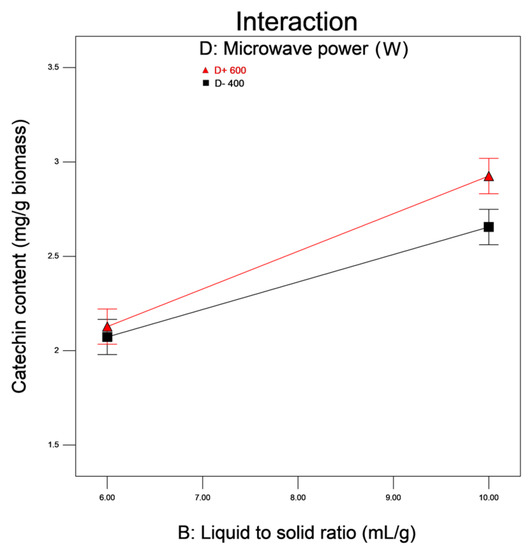
Figure 5.
Plot of significant interaction factors between liquid-to-solid ratio and microwave power on the catechin content (mg/g biomass) from extracts of P. spinosa branches (square, black line—400 W (−1), triangle, red line—600 W (+1) of microwave power).
Statistical analysis of Response 2, the epicatechin content, shows that the model F-value of 86.41 supports the significance of the obtained model (Table 5). The determination (R2) and the adjusted (adjusted R2) coefficients are 0.977 and 0.966, respectively, showing that the estimated model fits well with the experimental data. Diagnostic plots for studentized residuals pinpoint the fact that for the Normal plot the values are grouped along a straight line, while the Residuals vs. Predicted and Residuals vs. Run show a random scatter, with no trends (Figure 6).

Table 5.
ANOVA test for epicatechin content model.
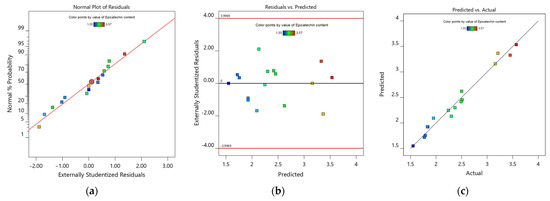
Figure 6.
(a) Normal probability plot for the residuals for R2 (epicatechin content); (b) Plot of residuals versus predicted values for R2 (epicatechin content); (c) Plot of residuals versus experimental values for R2 (epicatechin content). Square symbols are colored by R1 value, blue—the lowest, green—average, red—the highest.
Optimization of experimental conditions for MAE: the following equation was determined:
where R2 is the content of epicatechin (mg/g biomass), A is ethanolic solvent concentration, B is liquid-to-solid ratio, C is extraction time, D is microwave power and AB is the interaction between solvent concentration and liquid-to-solid ratio.
R2 = 2.41 + 0.3219A + 0.4831B + 0.0844C − 0.1031D + 0.1344AB
The factor plots (Figure 7) show the effects of the significant factors on the epicatechin content from P. spinosa extracts. The increase in the value of factors A (solvent concentration) and B (liquid-to-solid ratio) is reflected in an increase in the value of the response, a steeper slope meaning a greater influence on the recovery. Factor C (extraction time) also shows an increasing influence on the response, yet in a lower degree. Factor D (microwave power) shows a decreasing influence on the response. Similar to the results obtained for catechin content, in relation to the epicatechin content it can be concluded that an increase in ethanolic solvent concentration and liquid-to-solid ratio leads to higher recoveries of epicatechin content of the extract.
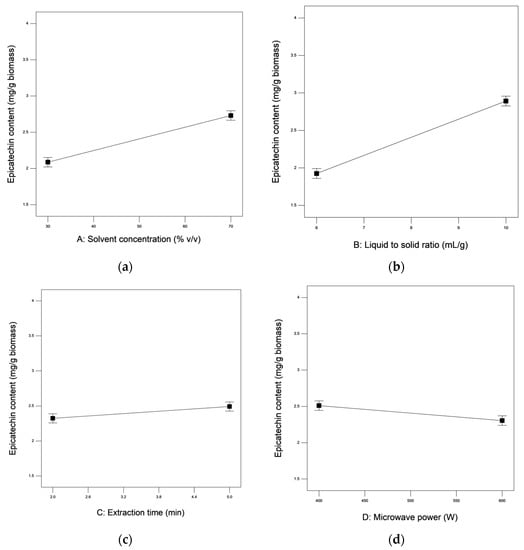
Figure 7.
Plots of marginal means of epicatechin content as influenced by (a) solvent concentration, (b) liquid-to-solid ratio, (c) extraction time and (d) microwave power.
Figure 8 presents a significant interaction effect on the extraction of epicatechin from P. spinosa branches. Interaction AB (solvent concentration with liquid-to-solid ratio) has a strong significant effect as shown by the p-value < 0.0001, and is due to both these factors making higher contributions to the epicatechin content, compared to the other two.
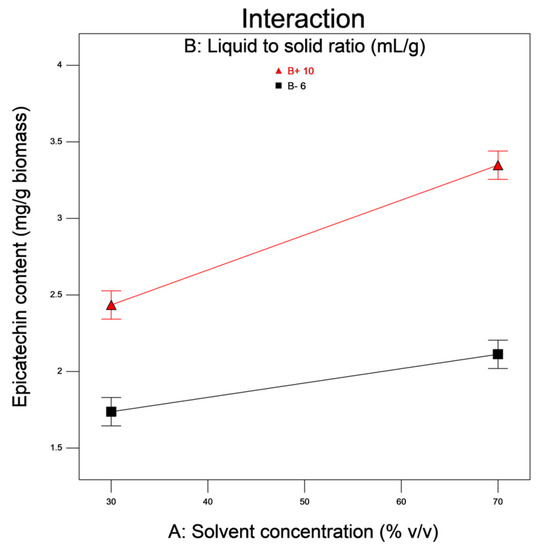
Figure 8.
Plot of significant interaction factors between solvent concentration and liquid-to-solid ratio on the epicatechin content (mg/g biomass) from extracts of P. spinosa branches (extraction time 3.5 min, microwave power 500 W, square, black line—6:1 mL/g (−1), triangle, red line—10:1 mL/g (+1) of liquid to solid ratio).
The optimum value for each independent variable was established by means of Design Expert software, with the optimization method described in detail by Secula et al. [45] and Singh et al. [46]. The optimization criteria for extracting catechin and epicatechin from P. spinosa branches using microwave-assisted extraction are presented in Table 6. The values of 70% v/v, 10:1, 5 min and 600 W for solvent concentration, liquid-to-solid ratio, extraction time and microwave power, were suggested to achieve the optimum value for the content of catechin and epicatechin.

Table 6.
Constraints for optimization of extraction parameters and responses.
Desirability is the closeness of the response value toward the target, [34] and the factor and response importance is assigned from 1 (least important) to 5 (most important).
Ramp function graphs (Figure 9) present the key factors (red dot) and their responses (blue dot), respectively. The height of the dot shows the desirability achieved upon the optimization process. A positive slope of the ramp corresponds to the maximization of the response (solvent concentration and liquid-to-solid ratio), whereas a flat ramp indicates a uniform desirability (extraction time and microwave power). A desirability achievement of 94.1% was obtained for the set criteria (Figure 9 and Figure 10) when P. spinosa branches were extracted with 70% v/v ethanolic solvent, in a liquid-to-solid proportion 10:1, for 5 min of extraction and 400 W microwave irradiation power, and resulted in an extract with 3.4 mg catechin/biomass and 3.45 mg epicatechin/biomass.
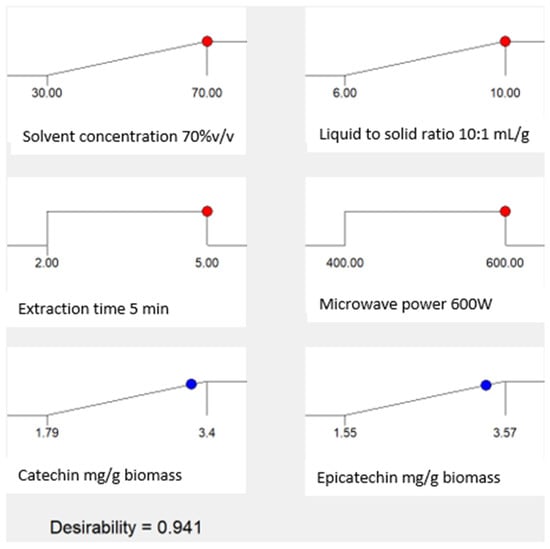
Figure 9.
Desirability ramps for optimization criteria—the optimal values of the design factors (red points—optimal factor values; blue points—Optimal response prediction values).
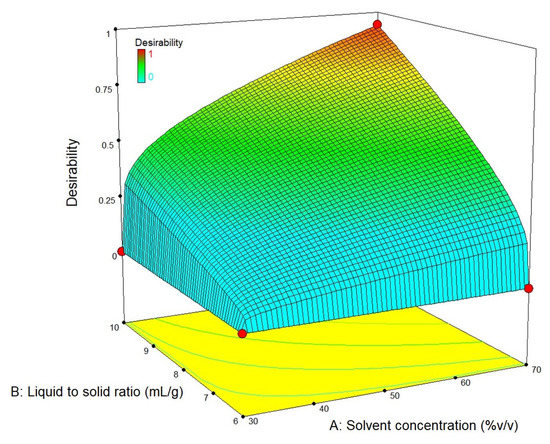
Figure 10.
Surface plot on desirability (effect of solvent concentration versus liquid-to-solid ratio).
Verification of the predictive model was performed by the evaluation of catechin and epicatechin content under the following conditions: with 70% v/v ethanolic solvent, in a liquid-to-solid proportion 10:1, for 5 min of extraction and 400 W microwave irradiation power. The experimental data verification is presented in Table 7.

Table 7.
Overall optimal values of extraction parameters for catechin and epicatechin from P. spinosa branches.
The experimental content for catechin and epicatechin (3.4 mg catechin/g biomass and 3.45 mg epicatechin/biomass) was consistent with the predicted value (3.245 mg catechin/g biomass and 3.329 mg epicatechin/biomass) under optimal conditions. The validation test proves the suggested models are accurate and reliable.
4. Conclusions
Microwave-assisted extraction is an unconventional green technique that can be used to extract the condensed tannins such as catechin and epicatechin from P. spinosa branches.
A two-level factorial design was employed to model and determine the optimal conditions for the extraction process.
The catechin and epicatechin content was significantly influenced by the liquid-to-solid ratio and the solvent concentration, whereas extraction time and microwave power had a lower influence.
The obtained model was used to optimize the extraction process in order to maximize the content of catechin and epicatechin. The maximum content for catechin (3.4 mg/g biomass) and epicatechin (3.45 mg/g biomass) was obtained in Run 16, using 70% v/v ethanol, 1:10 solid-to-liquid ratio, 5 min of extraction and 600 W microwave power.
The predicted values thus obtained for catechin and epicatechin content are in good agreement with the experimental values of the validation test, indicating the model’s suitability.
The biocompounds extracted using MAE show important biological active properties (antixodants, antitumor), comparable to those of pure standards. The stability of biocompounds separated by means of MAE will be the topic of a future work.
Author Contributions
O.T.C.: conceptualization, methodology, formal analysis, investigation, writing—original draft preparation; E.I.: methodology, investigation, validation; M.S.S.: conceptualization, methodology, investigation, formal analysis, data curation, validation, writing, review and editing; I.V.: conceptualization, validation, review and editing, resources, supervision. All authors have read and agreed to the published version of the manuscript.
Funding
PN-III-P4-PCE-2021-1455, (118/2022).
Data Availability Statement
Data is contained within the article.
Acknowledgments
This work was supported by a grant from the Ministry of Research, Innovation and Digitization, CNCS-UEFISCDI, project number PN-III-P4-PCE-2021-1455, (118/2022) within PNCDI III.
Conflicts of Interest
The authors declare no conflict of interest.
Appendix A
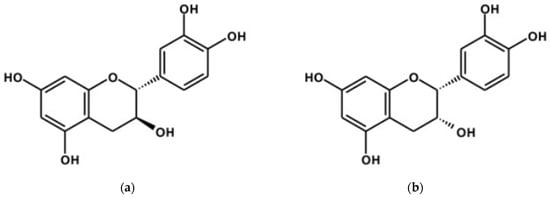
Figure A1.
Chemical structures of the main tannins: (a) (+)-catechin; (b) (−)-epicatechin.
Appendix B
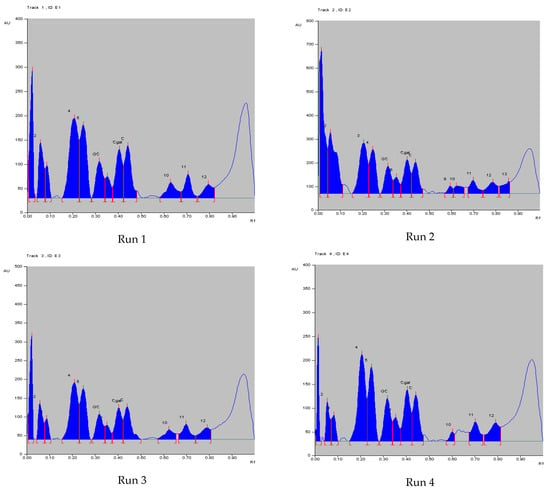
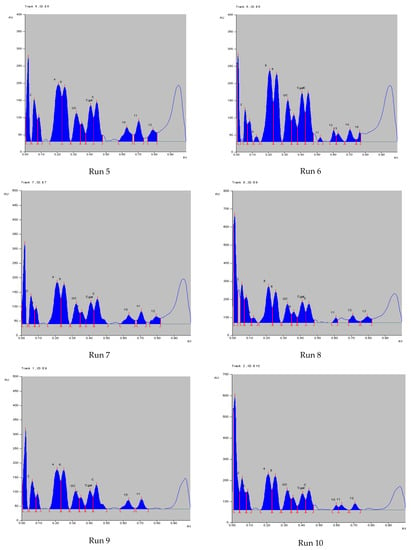
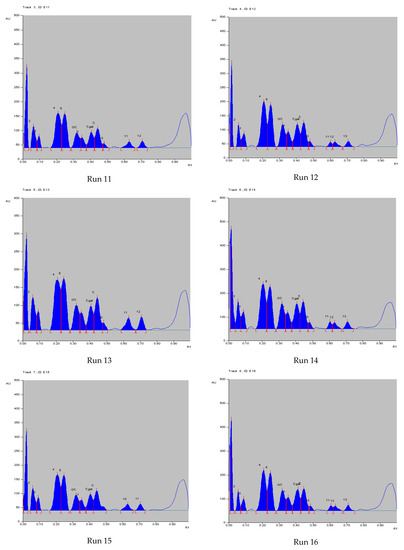
Figure A2.
Identification and densitometric quantification of catechin (C), P. spinosa extracts (Runs 1–16, Absorbance as a function of Retention factor).
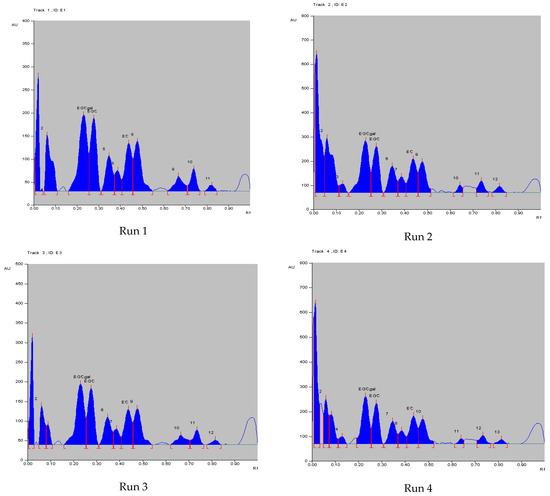
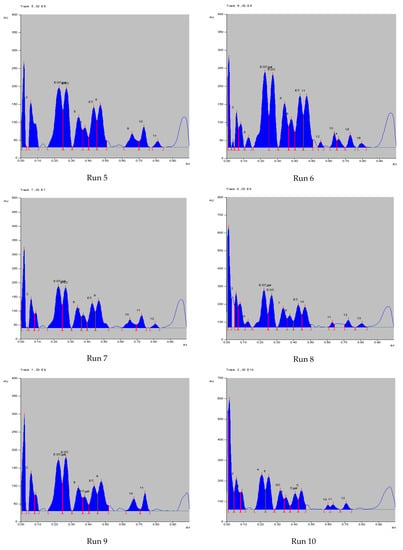
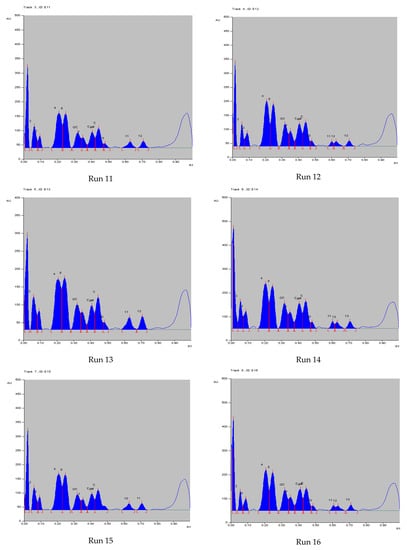
Figure A3.
Identification and densitometric quantification of epicatechin (EC), P. spinosa extracts (Runs 1–16, Absorbance as a function of Retention factor).
References
- Zhang, Q.W.; Lin, L.G.; Ye, W.C. Techniques for Extraction and Isolation of Natural Products: A Comprehensive Review. Chin. Med. 2018, 13, 20. [Google Scholar] [CrossRef] [PubMed]
- Kaufmann, B.; Christen, P. Recent Extraction Techniques for Natural, Products: Microwave-assisted Extraction and Pressurised Solvent Extraction. Phytochem. Anal. 2002, 13, 105–113. [Google Scholar] [CrossRef] [PubMed]
- Altemimi, A.; Lakhssassi, N.; Baharlouei, A.; Watson, D.; Lightfoot, D. Phytochemicals: Extraction, Isolation, and Identification of Bioactive Compounds from Plant Extracts. Plants 2017, 6, 42. [Google Scholar] [CrossRef] [PubMed]
- Azwanida, N.N. A Review on the Extraction Methods Use in Medicinal Plants, Principle, Strength and Limitation. Med. Aromat. Plants 2015, 4, 7. [Google Scholar]
- Routray, W.; Orsat, V. Microwave-Assisted Extraction of Flavonoids: A Review. Food Bioprocess Technol. 2012, 5, 409–424. [Google Scholar] [CrossRef]
- Nour, A.H.; Oluwaseun, A.R.; Nour, A.H.; Omer, M.S.; Ahmed, N. Microwave-Assisted Extraction of Bioactive Compounds (Review). In Microwave Heating; IntechOpen: London, UK, 2021. [Google Scholar] [CrossRef]
- Alvi, T.; Asif, Z.; Khan, M.K.I. Clean label extraction of bioactive compounds from food waste through microwave-assisted extraction technique—A review. Food Biosci. 2022, 46, 101580. [Google Scholar] [CrossRef]
- Yingngam, B.; Chiangsom, A.; Brantner, A. Modeling and Optimization of Microwave-Assisted Extraction of Pentacyclic Triterpenes from Centella Asiatica Leaves Using Response Surface Methodology. Ind. Crops Prod. 2020, 147, 112231. [Google Scholar] [CrossRef]
- Nisca, A.; Ștefănescu, R.; Moldovan, C.; Mocan, A.; Mare, A.D.; Ciurea, C.N.; Man, A.; Muntean, D.-L.; Tanase, C. Optimization of Microwave Assisted Extraction Conditions to Improve Phenolic Content and In Vitro Antioxidant and Anti-Microbial Activity in Quercus Cerris Bark Extracts. Plants 2022, 11, 240. [Google Scholar] [CrossRef]
- Tomasi, I.T.; Santos, S.C.R.; Boaventura, R.A.R.; Botelho, C.M.S. Microwave-Assisted Extraction of Polyphenols from Euca-lyptus Bark—A First Step for a Green Production of Tannin-Based Coagulants. Water 2023, 15, 317. [Google Scholar] [CrossRef]
- Bouras, M.; Chadni, M.; Barba, F.J.; Grimi, N.; Bals, O.; Vorobiev, E. Optimization of Microwave-Assisted Extraction of Pol-yphenols from Quercus Bark. Ind. Crops Prod. 2015, 77, 590–601. [Google Scholar] [CrossRef]
- Quiles-Carrillo, L.; Mellinas, C.; Garrigos, M.C.; Balart, R.; Torres-Giner, S. Optimization of Microwave-Assisted Extraction of Phenolic Compounds with Antioxidant Activity from Carob Pods. Food Anal. Methods 2019, 12, 2480–2490. [Google Scholar] [CrossRef]
- Gandhi, D.M.; Patel, H.; Patel, N.; Mehta, P. Optimization of Microwave-Assisted Extraction Technique for Isolation of Betu-linic Acid from Dillenia Indica Linn. and Its Quantification Using Developed HPTLC Method. J. App. Pharm. Sci. 2019, 9, 101–110. [Google Scholar]
- Bachtler, S.; Bart, H.J. Increase the Yield of Bioactive Compounds from Elder Bark and Annatto Seeds Using Ultrasound and Microwave Assisted Extraction Technologies. Food Bioprod. Process. 2021, 125, 1–13. [Google Scholar] [CrossRef]
- Ciuperca, O.T.; Tebrencu, C.E.; Lazar, L.; Volf, I. Kinetic Study on Solid-Liquid Extraction of Condensed Tannins from Rosa Canina Branches and Stems. Rev. Chim. 2020, 71, 153–161. [Google Scholar] [CrossRef]
- Patel, K.; Panchal, N.; Ingle, P. Review of Extraction Techniques Extraction Methods: Microwave, Ultrasonic, Pressurized Fluid, Soxhlet Extraction, Etc. Int. J. Adv. Res. Chem. Sci. 2019, 6, 6–21. [Google Scholar]
- Chupin, L.; Maunu, S.L.; Reynaud, S.; Pizzi, A.; Charrier, B.; Charrier-EL Bouhtoury, F. Microwave Assisted Extraction of Maritime Pine (Pinus Pinaster) Bark: Impact of Particle Size and Characterization. Ind. Crops Prod. 2015, 65, 142–149. [Google Scholar] [CrossRef]
- Abubakar, A.; Haque, M. Preparation of Medicinal Plants: Basic Extraction and Fractionation Procedures for Experimental Purposes. J. Pharm. Bioallied Sci. 2020, 12, 1–10. [Google Scholar] [CrossRef]
- Beszterda, M.; Frański, R. Detection of flavone C-glycosides in the extracts from the bark of Prunus avium L. and Prunus cerasus L. Eur. J. Mass Spectrom. 2020, 26, 369–375. [Google Scholar] [CrossRef]
- Ortega-Vidal, J.; Cobo, A.; Ortega-Morente, E.; Gálvez, A.; Martínez-Bailén, M.; Salido, S.; Altarejos, J. Antimicrobial activity of phenolics isolated from the pruning wood residue of European plum (Prunus domestica L.). Ind. Crops Prod. 2022, 176, 114296. [Google Scholar] [CrossRef]
- Arora, D.S.; Mahajan, H. Major Phytoconstituents of Prunus cerasoides Responsible for Antimicrobial and Antibiofilm Potential Against Some Reference Strains of Pathogenic Bacteria and Clinical Isolates of MRSA. Appl. Biochem. Biotechnol. 2019, 188, 1185–1204. [Google Scholar] [CrossRef]
- Adeel, S.; Rehman, F.; Pervaiz, M.; Hussaan, M.; Amin, N.; Majeed, A.; Rehman, H. Microwave Assisted Green Isolation of Laccaic Acid from Lac Insect (Kerria lacca) for Wool Dyeing. Prog. Color Color. Coat. 2021, 14, 293–299. [Google Scholar]
- PDR for Herbal Medicines, 4th ed.; Gruenwald, J., Ed.; Thomson Healthcare: Montvale, NJ, USA, 2007. [Google Scholar]
- Shi, S.; Li, J.; Sun, J.; Yu, J.; Zhou, S. Phylogeny and Classification of Prunus Sensu Lato (Rosaceae): Phylogeny and Classification of Prunus. J. Integr. Plant Biol. 2013, 55, 1069–1079. [Google Scholar] [CrossRef] [PubMed]
- Ciuperca, O.T.; Tebrencu, C.E.; Ionescu, E.; Iacob, E.; Volf, I. Studies on Polyphenols Isolated from Branches of Prunus spinosa L. Species. Rev. Chim. 2019, 70, 2897–2902. [Google Scholar] [CrossRef]
- Velickovic, I.; Zizak, Z.; Rajcevic, N.; Ivanov, M.; Sokovic, M.; Marin, P.; Grujic, S. Examination of the Polyphenol Content and Bioactivities of Prunus spinosa L. Fruit Extracts. Arch. Biol. Sci. 2020, 72, 105–115. [Google Scholar] [CrossRef]
- Popović, B.M.; Blagojević, B.; Ždero Pavlović, R.; Mićić, N.; Bijelić, S.; Bogdanović, B.; Mišan, A.; Duarte, C.M.M.; Serra, A.T. Comparison between Polyphenol Profile and Bioactive Response in Blackthorn (Prunus spinosa L.) Genotypes from North Serbia-from Raw Data to PCA Analysis. Food Chem. 2020, 302, 125373. [Google Scholar] [CrossRef] [PubMed]
- Yiğit, Ü.; Turabi Yolaçaner, E.; Hamzalıoğlu, A.; Gökmen, V. Optimization of Microwave-assisted Extraction of Anthocyanins in Red Cabbage by Response Surface Methodology. J. Food Process. Preserv. 2022, 46, e16120. [Google Scholar] [CrossRef]
- Barros, L.; Carvalho, A.M.; Morais, J.S.; Ferreira, I.C.F.R. Strawberry-Tree, Blackthorn and Rose Fruits: Detailed Characteri-sation in Nutrients and Phytochemicals with Antioxidant Properties. Food Chem. 2010, 120, 247–254. [Google Scholar] [CrossRef]
- Pinacho, R.; Cavero, R.Y.; Astiasarán, I.; Ansorena, D.; Calvo, M.I. Phenolic Compounds of Blackthorn (Prunus spinosa L.) and Influence of in Vitro Digestion on Their Antioxidant Capacity. J. Funct. Foods 2015, 19, 49–62. [Google Scholar] [CrossRef]
- Karakas, N.; Okur, M.E.; Ozturk, I.; Ayla, S.; Karadağ, A.E.; Polat, D.Ç. Antioxidant Activity and Cytotoxic Effects of Prunus spinosa L. Fruit Extract on Various Cancer Cell Lines. Medeni. Med. J. 2019, 34, 297–304. [Google Scholar] [CrossRef]
- Frey, D.D.; Engelhardt, F.; Greitzer, E.M. A Role for “One-Factor-at-a-Time” Experimentation in Parameter Design. Res. Eng. Des. 2003, 14, 65–74. [Google Scholar] [CrossRef]
- Alara, O.R.; Abdurahman, N.H.; Olalere, O.A. Ethanolic Extraction of Flavonoids, Phenolics and Antioxidants from Vernonia Amygdalina Leaf Using Two-Level Factorial Design. J. King Saud. Univ. Sci. 2020, 32, 7–16. [Google Scholar] [CrossRef]
- Anderson, M.J.; Whitcomb, P.J. RSM Simplified; Productivity Press: New York, NY, USA, 2016. [Google Scholar]
- Lucas, J.M. Response Surface Methodology: Process and Product Optimization Using Designed Experiments; Taylor & Francis: Abingdon, UK, 2010. [Google Scholar]
- Reich, E.; Schibli, A. High-Performance Thin-Layer Chromatography for the Analysis of Medicinal Plants; Thieme: New York, NY, USA, 2007. [Google Scholar]
- Wagner, H.; Bladt, S. Plant Drug Analysis: A Thin Layer Chromatography Atlas, 2nd ed.; Springer: Berlin, Germany, 2009. [Google Scholar]
- Bejenari, I.; Hristea, G.; Carausu, C.; Mija, A.; Volf, I. A Sustainable Approach on Spruce Bark Waste Valorisation through Hydrothermal Conversion. Processes 2022, 10, 111. [Google Scholar] [CrossRef]
- NREL. Biomass Compositional Analysis Laboratory Providing Detailed and Accurate Characterization; National Renewable Energy Laboratory (NREL): Golden, CO, USA, 2014.
- Chew, K.K.; Ng, S.Y.; Thoo, Y.Y.; Khoo, M.Z.; Wan Aida, W.M.; Ho, C.W. Effect of Ethanol Concentration, Extraction Time and Extraction Temperature on the Recovery of Phenolic Compounds and Antioxidant Capacity of Centella Asiatica Extracts. Int. Food Res. J. 2011, 18, 571–578. [Google Scholar]
- Hithamani, G.; Ramalakshmi, K.; Hithamani, G.; Ramalakshmi, K. Microwave Assisted Extraction of Phenolics from Origanum Vulgare. Int. Invent. J. Agric. Soil Sci. 2020, 1, 7–12. [Google Scholar]
- Do, Q.D.; Angkawijaya, A.E.; Tran-Nguyen, P.L.; Huynh, L.H.; Soetaredjo, F.E.; Ismadji, S.; Ju, Y.-H. Effect of Extraction Solvent on Total Phenol Content, Total Flavonoid Content, and Antioxidant Activity of Limnophila aromatica. J. Food Drug Anal. 2014, 22, 296–302. [Google Scholar] [CrossRef]
- Dahmoune, F.; Nayak, B.; Moussi, K.; Remini, H.; Madani, K. Optimization of Microwave-Assisted Extraction of Polyphenols from Myrtus communis L. Leaves. Food Chem. 2015, 166, 585–595. [Google Scholar] [CrossRef] [PubMed]
- Li, Y.; Han, L.; Ma, R.; Xu, X.; Zhao, C.; Wang, Z.; Chen, F.; Hu, X. Effect of Energy Density and Citric Acid Concentration on Anthocyanins Yield and Solution Temperature of Grape Peel in Microwave-Assisted Extraction Process. J. Food Eng. 2012, 109, 274–280. [Google Scholar] [CrossRef]
- Secula, M.S.; Stan, C.S.; Cojocaru, C.; Cagnon, B.; Cretescu, I. Multi-Objective Optimization of Indigo Carmine Removal by an Electrocoagulation/GAC Coupling Process in a Batch Reactor. Sep. Sci. Technol. 2014, 49, 924–938. [Google Scholar] [CrossRef]
- Singh, R.; Singh, P.; Pandey, V.K.; Dash, K.K.; Ashish; Mukarram, S.A.; Harsányi, E.; Kovács, B. Microwave-Assisted Phytochemical Extraction from Walnut Hull and Process Optimization Using Box–Behnken Design (BBD). Processes 2023, 11, 1243. [Google Scholar] [CrossRef]
Disclaimer/Publisher’s Note: The statements, opinions and data contained in all publications are solely those of the individual author(s) and contributor(s) and not of MDPI and/or the editor(s). MDPI and/or the editor(s) disclaim responsibility for any injury to people or property resulting from any ideas, methods, instructions or products referred to in the content. |
© 2023 by the authors. Licensee MDPI, Basel, Switzerland. This article is an open access article distributed under the terms and conditions of the Creative Commons Attribution (CC BY) license (https://creativecommons.org/licenses/by/4.0/).